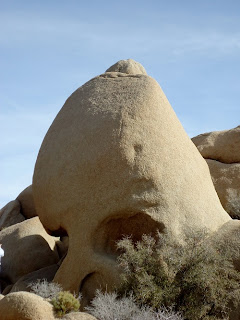One time I saw a tiny Joshua tree sapling growing not too far from the old tree. I wanted to dig it up and replant it near our house. I told Mom that I would protect it from the wind and water it every day so that it could grow nice and tall and straight. Mom frowned at me. "You'd be destroying what makes it special," she said. "It's the Joshua tree's struggle that gives it its beauty.”
Jeannette Walls
Even though I have lived in San Diego for over 30 years, I had never visited Joshua Tree National Park until last year. It is only about 3 hours drive from San Diego, so it seems we might have visited it sooner, but somehow we had passed it by. We took a weeks vacation in Palm Spring last year, and while there decided to drive over and check it out. I really didn't know much about the park before we went, but figured it must be of some interest or it wouldn't have made it as a National Park. I was pleasantly surprised. We had a very enjoyable day exploring the park. And it was only a short drive from Palm Springs. Anyone visiting Palm Springs for any length of time should consider a day trip over to the park.
 |
| Joshua Tree in the park |
While the desert landscape is gorgeous throughout the park in all seasons, perhaps the most spectacular features are the rocks. Huge granite boulders soar overhead enticing rock climbers from around the world. The sight of these huge rock monoliths against a bright blue sky combined with the Joshua trees makes for a unique,and beautiful landscape.
The park encompasses over one million acres of pristine desert scenery. Two deserts with their own separate ecosystems merge within the park. The eastern part of the park contains the Colorado Desert at elevations below 3,000 feet. Spiny ocotillo plants, creosote bushes and cholla cactus dominate the eastern section. The higher Mojave Desert occupies the western part of the park. It is in the Mojave, slightly cooler and moister, where the Joshua Trees grow.
Joshua Tree became a National Monument in 1936 and was upgraded to a National Park in 1994. The park offers visitors lots of opportunities for exploration and discovery, depending on how much time you have to explore the park and what your interests are.
 |
| My dogs enjoying the park |
 |
| Large Rock Formations in the park |
Joshua Tree is home to abundant wildlife including bobcats, coyotes, golden eagles, burrowing owls, roadrunners, sidewinders and tarantulas. While the desert may seem unforgiving and difficult to live in, animals have adapted in order to survive. For example, the Kangaroo Rat is especially adapted for life in the harsh desert. He lives off of seeds alone, getting all the nutrients and water he needs from the seeds. Together with his sense of smell and his front paws, he sifts through the sand in search of these tiny, life giving seeds. His large rear paws are adapted for travel over the desert sand.
 |
| We spotted this coyote while in the park |
If you have more than one day to spend in the park then you might want to stay in the park. There are nine campgrounds in the park, plus backcountry camping is permitted. Almost 500 campsites nestled amongst the boulders makes for a one of a kind camp experience. While RVs are welcome, hookups are not available. The majority of the campgrounds cost between $5 and $10 and are first come, first served. Group sites (which cost $20-$35), Indian Cove and Black Rock accept reservations. Campgrounds fill up fast, especially in the spring. Arrive early for the best chance of obtaining a campsite. For more information about the campgrounds, go to: www.nps.gov/jotr/planyourvisit/camping.htm
 |
| Skull Rock, in Joshua Tree NP |
College kids on spring break fill the campgrounds in April and March but tend to be a more subdued crowd than the stereotypical spring breakers found elsewhere. Summer brings temperatures of over 100 degrees, not the best time to visit. Fall and winter bring cooler days with fall's temperatures in the 80s and winter in the 60s. Visitation increases as temperatures moderate in the fall, peaks during spring wildflower season, and diminishes during the heat of summer. There are entrance fees, but as with all National Parks, they accept the National Park passes, and senior passes. For information on the passes and the fees, go to http://www.nps.gov/jotr/planyourvisit/feesandreservations.htm
Joshua Tree National Park is an interesting park to visit. It is different than other parks that we have visited, and we enjoyed our day of exploring it. If you are in the area, you should definitly check it out. It does make a nice day trip from Palm Springs. We also visited a ghost town that was between Palm Springs and the park, and that made a nice stop along the way.
 |
| Old West Town near Joshua Tree NP |


No comments:
Post a Comment